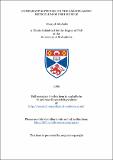Files in this item
Comparative studies on the sarcoplasmic reticulum of fish muscle
Item metadata
| dc.contributor.advisor | Johnston, Ian A. | |
| dc.contributor.author | McArdle, Harry J. | |
| dc.coverage.spatial | 165 p. | en_US |
| dc.date.accessioned | 2018-07-06T11:14:01Z | |
| dc.date.available | 2018-07-06T11:14:01Z | |
| dc.date.issued | 1980 | |
| dc.identifier.uri | https://hdl.handle.net/10023/15047 | |
| dc.description.abstract | 1. The sarcoplasmic reticulum from fish red and white muscle has been isolated and compared with that of mammalian sarcoplasmic reticulum (SR). The white muscle SR is shown to be similar to mammalian fast muscle with the majority of the protein being accounted for by a band with molecular weighty of approximately 100,000. This has been demonstrated in several species to correspond to the calcium pump protein. The red muscle SR pumps Ca2+ ions and hydrolyses ATP at approximately half the rate of the white SR. Gel electrophoresis of the SR vesicles shows that there is not sufficient 100,000 dalton protein in the red muscle SR to account for the relative rates of pumping. It is suggested that fish red muscle SR resembles mammalian slow fibres in that the pump protein's molecular weight is not the same as the white. Unlike mammalian SR, vesicles isolated from trout red muscle or not stimulated by commercially available cAMP dependent protein kinases. 2. The microsomal pellet of muscle is generally contaminated with mitochondrial fragments and sarcolemmal vesicles. Pure sarcoplasmic reticulum fractions have been obtained from plaice 2+ 2+ muscle and the characteristics of the Ca2+ ATPase and Ca2+ uptake studied. The protein composition of the vesicles, the dependence on Mg2+, Ca2+, K+ and ADP are demonstrated to be similar to that of rabbit muscle. A comparison of the levels of the phosphorylated enzyme intermediate with those obtained by other workers shows that the pump protein concentration is similar to rabbit fast skeletal muscle. 3. The effect of evolutionary temperature adaptation on the sarcoplasmic reticulum of different species of fish has been examined. The Ca2+ ATPase shows an inverse h correlation with the cell temperature of the species at O°C, and this difference is reflected in the relative rates of Ca2+ uptake. Activation enthalpy increases with increasing environmental temperature, while activation entropy goes from negative values in .the cold adapted to positive values in the hot adapted species. Unlike other enzyme systems, the activation energy shows no correlation with temperature. Acclimation to seasonal temperature changes has also been studied. Unlike adaptation on evolutionary time scales, acclimation does not affect the activation entropy of the ATPase, and there is no significant difference in the rates of ATP hydrolysis. It is concluded that the mechanisms of compensation are different in adaption to evolutionary and seasonal temperature changes. Evidence for acclimation to low temperatures involving an increase in the amount of sarcoplasmic reticulum is reviewed. 4. The enzyme-substrate affinity has been monitored by measuring the KCa of the Ca2+ ATPase at different temperatures for four different species of teleost. As with the Vmax estimations, compensatory changes are shown in the ATPase. KCa values, estimated at O°C are found to be inversely related Ca. to the animal's cell temperature. When estimated at that temperature, the values are similar. These results are discussed in relation to the observed prepondence of parvalbumins in fish muscle, and a possible role of the parvalbumins is considered. 5. In even the purest of SR preparations, i.e. those with no contaminating marker enzymes, a Ca2+ independent ATPase activity can be demonstrated. Unlike the Ca2+-ATPase the Ca2+ -independent ATPase activity is not related to habitat temperature, and the activation entropy is not proportional to cell temperature. As shown in the, rabbit, incubation of the SR in the presence of 0.1% Triton X-100 converts the basal ATPase activity in all except the lightest fractions to Ca2+ dependence. It is suggested that the Ca2+ independent ATPase represents a form of the pump protein uncoupled from Ca2+ transport, with the two forms of the ATPase in thermal equilibrium. Supportive evidence is provided for this theory. The ratio of Ca2+ dependent to total ATPase is temperature dependent, increasing to maximal value at and above the animal's cell temperature. For example, the ratio of approximately 0.25 at O°C in Tilapia mariae (a tropical species), increasing to 0.85 at 25°0. In contrast, the ratio for Myoxocephalus scorpius (North Sea) is only slightly affected by assay temperature and remains at about 0.95 throughout the range O - 33°C. The activation energy for the conversion has been estimated for two species and compared with that of rabbit. It is possible that the contribution of the activation energy for the conversion may account for the poor correlation of the DeltaG# of the Ca2+-dependent ATPase with environment temperature. | en_US |
| dc.language.iso | en | en_US |
| dc.publisher | University of St Andrews | |
| dc.subject.lcc | QL831.M2 | |
| dc.subject.lcsh | Muscles | en |
| dc.title | Comparative studies on the sarcoplasmic reticulum of fish muscle | en_US |
| dc.type | Thesis | en_US |
| dc.type.qualificationlevel | Doctoral | en_US |
| dc.type.qualificationname | PhD Doctor of Philosophy | en_US |
| dc.publisher.institution | The University of St Andrews | en_US |
This item appears in the following Collection(s)
Items in the St Andrews Research Repository are protected by copyright, with all rights reserved, unless otherwise indicated.

